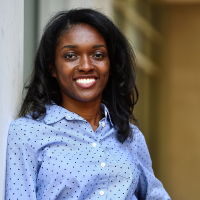
Johns Hopkins University │ Baltimore, Maryland
For her contributions to the novel design of medical imaging systems involving ultrasound and light that make robotic and non-robotic guided surgery safer and more effective.
Muyinatu “Bisi” Bell has emerged as one of the most innovative minds in biomedical engineering, reshaping medical imaging through her pioneering work on photoacoustic imaging and advanced ultrasound technologies. Combining expertise in engineering, optics, acoustics, and artificial intelligence, Bell has developed groundbreaking methods that enable clearer, more accurate, and safer diagnostic tools, opening new possibilities for surgeons and clinicians alike. Her career stands as a powerful example of how interdisciplinary creativity and lived experience can transform medical practice and patient care.
Born in Brooklyn, New York, Bell displayed an early aptitude for math and science, excelling academically from childhood. She tested into Brooklyn Technical High School, then pursued higher education at the Massachusetts Institute of Technology (MIT), earning her bachelor’s degree in mechanical engineering. Her time at MIT cultivated a fascination with the intricate connections between engineering and medicine, and she began to envision a career dedicated to developing technologies that improve human lives. She continued her studies at Duke University, earning her Ph.D. in biomedical engineering. As a postdoctoral fellow at Johns Hopkins University, Bell began forging the ideas that would define her ultimate professional trajectory—the integration of robotics, artificial intelligence, and real-time image processing into medical imaging.
Bell’s doctoral research laid the foundation for these future innovations, focusing on techniques to overcome the limitations of conventional ultrasound imaging. Ultrasound had long been widely used due to its affordability and safety but often suffered from image quality challenges. Traditional ultrasound machines work by sending acoustic waves through the body and converting the reflections into imagery. Natural variations in human anatomy and tissue properties lead to multiple unpredictable reflections, which appear in imagery as noise or "clutter." Because of clutter and other limiting factors, ultrasound struggles to detect subtle differences in tissue types, such as differentiating between tumors and fluid-filled cysts, or precisely delineating the margins of known structures in the heart walls. Recognizing that the same limitations exist when ultrasound is combined with light, Bell explored the potential of photoacoustic imaging, which is an innovative technique that combines laser-induced light pulses with ultrasound detection. She demonstrated the ability of photoacoustic imaging to provide richer, more detailed tissue characterization by exploiting differences in optical absorption among various tissues.
Her pioneering efforts in ultrasound and photoacoustic imaging evolved into the creation of novel imaging algorithms capable of removing clutter and clarifying subtle anatomical features in real time. By incorporating advanced deep learning algorithms, Bell has successfully developed methods that help clinicians automatically distinguish between healthy and diseased tissues, and dramatically improve diagnostic accuracy, surgical guidance, and ultrasound efficacy for people with darker skin tones (light absorption by melanin in skin contributes to acoustic clutter). These algorithms, trained on extensive clinical data, stand to significantly reduce surgical complications and improve patient safety, especially in delicate procedures like neurosurgery and cancer surgery.
In 2017, Bell joined the faculty of Johns Hopkins University as an assistant professor in the Department of Electrical and Computer Engineering. At Hopkins, she founded and currently leads the Photoacoustic and Ultrasonic Systems Engineering (PULSE) Lab, a research group dedicated to pushing the boundaries of biomedical imaging technology. Under Bell’s leadership, the PULSE Lab has become internationally recognized for its innovations in both photoacoustic imaging and advanced ultrasound, particularly in developing image guidance techniques that significantly enhance surgical accuracy and patient outcomes for a wider diversity of people.
One of her most recent innovations is her groundbreaking application of photoacoustic imaging to guide robotic surgery. In procedures traditionally dependent on visual inspection alone, surgeons face significant challenges detecting hidden blood vessels, nerves, and other important structures. Bell’s photoacoustic technologies produce high-resolution, real-time images of critical anatomical structures, even beneath opaque tissues. The integration of this technology into robotic surgical platforms has been hailed as a transformative advancement, enabling surgeons to navigate complex surgical sites and reduce the risk of inadvertent injury to vital tissues.
Bell’s innovative contributions have earned widespread recognition from both the scientific community and industry leaders. She was honored as one of MIT Technology Review’s “Innovators Under 35,” selected as a Sloan Research Fellow, and received numerous prestigious awards, including the National Institutes of Health (NIH) Trailblazer Award and National Science Foundation (NSF) CAREER Award. She has also been recognized for her outstanding commitment to mentoring young engineers, particularly women and minorities in STEM fields, fostering diversity and inclusion within engineering and medicine.
Bell’s tireless efforts extend beyond research. She is deeply involved in translating her laboratory discoveries into practical clinical tools, working closely with hospitals, surgeons, and medical technology companies. By bridging academia and industry, Bell ensures that her technologies are not only scientifically innovative but also practically implementable, scalable, and widely accessible. She regularly partners with leading clinicians, demonstrating how engineering breakthroughs can directly enhance surgical precision and patient care.
Beyond her technical achievements, Bell serves as a powerful advocate for greater representation in STEM. Recognizing the challenges faced by women and minoritized groups underrepresented in engineering and science, she frequently speaks at educational events, promotes outreach initiatives, and actively mentors the next generation of diverse engineering leaders. Her presence inspires many aspiring engineers and scientists to pursue careers where they can make tangible impacts on society.
Today, Muyinatu Bell continues to lead transformative research that merges sophisticated computational techniques, robotics, optics, and acoustics to revolutionize medical imaging. Her innovations demonstrate the extraordinary potential of interdisciplinary collaboration. By redefining the capabilities of imaging technology, Bell ensures that clinicians around the world have access to more powerful, inclusive, and effective tools, firmly establishing her legacy as a leader who has profoundly shaped the future of biomedical engineering.
Information as of April 2025.

